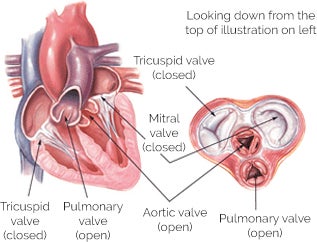
Heart Basics
How the heart valves work
Human heart valves are remarkable structures. These tissue-paper thin membranes attached to the heart wall constantly open and close to regulate blood flow (causing the sound of a heartbeat). This flexing of the tissue occurs day after day, year after year. In fact, the tissue withstands about 80 million beats a year, or 5 to 6 billion beats in an average lifetime. Each beat is an amazing display of strength and flexibility.
The heart has 4 valves:
- The mitral valve and tricuspid valve, which control blood flow from the atria to the ventricles
- The aortic valve and pulmonary valve, which control blood flow out of the ventricles

Diagram shows heart during systole (ventricles contracting)
A normal, healthy heart valve minimizes any obstruction and allows blood to flow smoothly and freely in one direction. It closes completely and quickly, not allowing any blood to flow back through the valve.
This information is not a substitute for talking with your doctor.